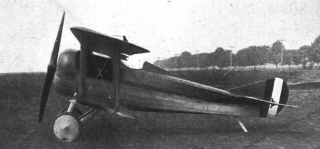
The Fokker E.IV was the final variant of the Eindecker fighter aircraft that was operated by Germany during World War I.

The Albatros D.XI was a German single-seat fighter sesquiplane first flown in February 1918. It was the first Albatros fighter to use a rotary engine, in the form of the 120 kW (160 hp) Siemens-Halske Sh.III, and also featured a new wing construction with diagonal struts from the fuselage replacing traditional wire bracing.

The Pfalz D.VIII was a German World War I fighter aircraft.
The Friedrichshafen FF.43 was a German single-seat floatplane fighter of the 1910s produced by Flugzeugbau Friedrichshafen.

The Hansa-Brandenburg W.19 was a German fighter-reconnaissance aircraft of World War I. It was a single-engined two-seat biplane floatplane, and was a larger development of the successful W.12. It served with the Kaiserliche Marine during 1918.

The Hansa Brandenburg W.27 and W.32 were prototype fighter floatplanes developed in parallel in Germany during World War I. They were developments of and intended replacements for the W.12 then in service and differed from each other principally in the choice of powerplant, the W.27 with a Benz Bz.IIIb and the W.32 with the same Mercedes D.III that the original W.12 used.

The Morane-Saulnier AI is a French parasol-wing fighter aircraft that was produced by Morane-Saulnier during World War I.
The Vickers E.F.B.8 was a prototype British twin-engined fighter of the First World War. It was abandoned after only one aircraft was built, single-engined fighters being considered to have superior manoeuvrability.

The Orenco B was a prototype American fighter aircraft of World War I. It was a single-engined, single-seat biplane that flew in 1918. Although it demonstrated good performance, it did not enter large scale service.
The Kondor E 3, sometimes erroneously known as E.III, was a German single seat, monoplane fighter aircraft designed and built close to the end of World War I. Though successful in the third D-type fighter competition at Aldershof in September 1918, only a few were produced, given the Idflieg designation of Kondor D.I.

The Kondor D 6 was a prototype German biplane fighter aircraft flown in 1918. In the interests of better upward vision for the pilot, its upper wing was in two halves, separated over the central fuselage. Its development was soon abandoned.

The Pfalz D.VII was a German biplane fighter aircraft from World War I. It was not put into production.

The Aviatik D.VII was a prototype German single-seat biplane fighter aircraft built by Aviatik in the last year of the First World War. It could not participate in the Third Fighter Competition of October 1918 because it used the wrong engine and it saw no military service, although 50 aircraft were found in storage after the war. The only real major change from the earlier Aviatik D.VI was a completely new tail structure.

In October 1917 Nieuport began construction of a prototype monoplane fighter known as the Nieuport Madon, a strut braced monoplane.

The Zeppelin-Lindau CS.I was a German single-engined reconnaissance seaplane with a low-wing monoplane layout.

The Kondor D 2 was a German single seat, biplane fighter aircraft designed and built close to the end of World War I.

The Friedrichshafen D.I was a German single-seat fighter plane developed by the Flugzeugbau Friedrichshafen during the First World War. Two prototypes were flown in 1917, but it was judged inferior to the Albatros D.III then in production and no further production ensued.

The Aviatik D.VI was a German prototype single-seater fighter aircraft of the First World War, designed by Aviatik.

The Hansa-Brandenburg W.16 was a floatplane fighter built in Germany during World War I for the Imperial German Navy.

The Courtois-Suffit Lescop CSL C1 was a prototype French biplane fighter built in the final months of World War I by the Société Anonyme d'Application Industrial du Bois (S.A.I.B.). It was among the first aircraft to be fitted with leading-edge flaps on the lower wing. It was not put into production.

















